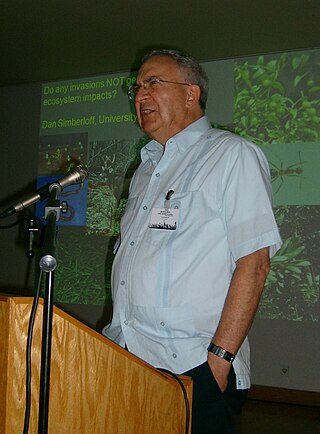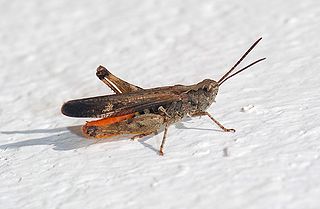Related Research Articles
Speciation is the evolutionary process by which populations evolve to become distinct species. The biologist Orator F. Cook coined the term in 1906 for cladogenesis, the splitting of lineages, as opposed to anagenesis, phyletic evolution within lineages. Charles Darwin was the first to describe the role of natural selection in speciation in his 1859 book On the Origin of Species. He also identified sexual selection as a likely mechanism, but found it problematic.

In evolutionary biology, sympatric speciation is the evolution of a new species from a surviving ancestral species while both continue to inhabit the same geographic region. In evolutionary biology and biogeography, sympatric and sympatry are terms referring to organisms whose ranges overlap so that they occur together at least in some places. If these organisms are closely related, such a distribution may be the result of sympatric speciation. Etymologically, sympatry is derived from Greek συν (sun-) 'together' and πατρίς (patrís) 'fatherland'. The term was coined by Edward Bagnall Poulton in 1904, who explains the derivation.

Daniel Simberloff is an American biologist and ecologist. He earned his Ph.D. from Harvard University in 1969. He is currently Gore Hunger Professor of Environmental Science at the University of Tennessee, editor-in-chief of the journal Biological Invasions, and a member of the National Academy of Sciences.

Masatoshi Nei was a Japanese-born American evolutionary biologist.

Chorthippus brunneus, also known as the common field grasshopper, is a species of grasshopper of the subfamily Gomphocerinae. The species is common and widespread in the Western Palearctic, and the IUCN lists it as Least Concern.

Pseudochorthippus parallelus, the meadow grasshopper, is a common species of grasshopper in the tribe Gomphocerini. It is found in non-arid grasslands throughout the well vegetated areas of Europe and some adjoining areas of Asia. It is a well-studied organism in the discipline of evolutionary biology and was an early and important model system for the study of European phylogeography.

Gryllus pennsylvanicus is known as the fall field cricket. G. pennsylvanicus is common in southern Ontario, is widespread across much of North America and can be found even into parts of northern Mexico. It tends to be absent in most of the southwestern United States including southern California. Within its geographic range this field cricket will burrow into soil in fields and forest edges. Individuals inhabit grassy disturbed areas and are often found around areas of human habitation.
Mary Jane West-Eberhard is an American theoretical biologist noted for arguing that phenotypic and developmental plasticity played a key role in shaping animal evolution and speciation. She is also an entomologist notable for her work on the behavior and evolution of social wasps.
Jody Hey is an evolutionary biologist at Temple University. In the 1980s and 1990s he did research on natural selection and species divergence in fruit flies (Drosophila). More recently he has worked on the development of methods for studying evolutionary divergence, on the divergence of cichlid fishes from Lake Malawi, on chimpanzees and on human populations. His research on divergence and speciation also lead him to study the difficulties of identifying species.

Günter P. Wagner is an Austrian-born evolutionary biologist who is Professor of Ecology and Evolutionary biology at Yale University, and head of the Wagner Lab.

Godfrey Matthew Hewitt was a British professor and evolutionary geneticist at the University of East Anglia who was very influential in the development of the fields of molecular ecology, phylogeography, speciation and hybridisation.
Parthenogenesis is a mode of asexual reproduction in which offspring are produced by females without the genetic contribution of a male. Among all the sexual vertebrates, the only examples of true parthenogenesis, in which all-female populations reproduce without the involvement of males, are found in squamate reptiles. There are about 50 species of lizard and 1 species of snake that reproduce solely through parthenogenesis. It is unknown how many sexually reproducing species are also capable of parthenogenesis in the absence of males, but recent research has revealed that this ability is widespread among squamates.

Andrew J. Roger is a Canadian-Australian molecular biologist and evolutionary bioinformatician. He is currently a professor in the Department of Biochemistry and Molecular Biology at Dalhousie University and was the founding director of the inter-departmental Centre for Comparative Genomics and Evolutionary Bioinformatics (CGEB).

Reinforcement is a process of speciation where natural selection increases the reproductive isolation between two populations of species. This occurs as a result of selection acting against the production of hybrid individuals of low fitness. The idea was originally developed by Alfred Russel Wallace and is sometimes referred to as the Wallace effect. The modern concept of reinforcement originates from Theodosius Dobzhansky. He envisioned a species separated allopatrically, where during secondary contact the two populations mate, producing hybrids with lower fitness. Natural selection results from the hybrid's inability to produce viable offspring; thus members of one species who do not mate with members of the other have greater reproductive success. This favors the evolution of greater prezygotic isolation. Reinforcement is one of the few cases in which selection can favor an increase in prezygotic isolation, influencing the process of speciation directly. This aspect has been particularly appealing among evolutionary biologists.

The scientific study of speciation — how species evolve to become new species — began around the time of Charles Darwin in the middle of the 19th century. Many naturalists at the time recognized the relationship between biogeography and the evolution of species. The 20th century saw the growth of the field of speciation, with major contributors such as Ernst Mayr researching and documenting species' geographic patterns and relationships. The field grew in prominence with the modern evolutionary synthesis in the early part of that century. Since then, research on speciation has expanded immensely.

Reinforcement is a process within speciation where natural selection increases the reproductive isolation between two populations of species by reducing the production of hybrids. Evidence for speciation by reinforcement has been gathered since the 1990s, and along with data from comparative studies and laboratory experiments, has overcome many of the objections to the theory. Differences in behavior or biology that inhibit formation of hybrid zygotes are termed prezygotic isolation. Reinforcement can be shown to be occurring by measuring the strength of prezygotic isolation in a sympatric population in comparison to an allopatric population of the same species. Comparative studies of this allow for determining large-scale patterns in nature across various taxa. Mating patterns in hybrid zones can also be used to detect reinforcement. Reproductive character displacement is seen as a result of reinforcement, so many of the cases in nature express this pattern in sympatry. Reinforcement's prevalence is unknown, but the patterns of reproductive character displacement are found across numerous taxa, and is considered to be a common occurrence in nature. Studies of reinforcement in nature often prove difficult, as alternative explanations for the detected patterns can be asserted. Nevertheless, empirical evidence exists for reinforcement occurring across various taxa and its role in precipitating speciation is conclusive.
Maria R. Servedio is a Canadian-American professor at the University of North Carolina at Chapel Hill. Her research spans a wide range of topics in evolutionary biology from sexual selection to evolution of behavior. She largely approaches these topics using mathematical models. Her current research interests include speciation and reinforcement, mate choice, and learning with a particular focus on evolutionary mechanisms that promote premating (prezygotic) isolation. Through integrative approaches and collaborations, she uses mathematical models along with experimental, genetic, and comparative techniques to draw conclusions on how evolution occurs. She has published extensively on these topics and has more than 50 peer-reviewed articles. She served as Vice President in 2018 of the American Society of Naturalists, and has been elected to serve as President in 2023.
Tanja Schwander is a Swiss evolutionary biologist and professor at the University of Lausanne. She is known for her work on the Evolution of sexual reproduction.
Michael Gordon Ritchie is a British evolutionary biologist and professor at the University of St Andrews. He is known for his work on speciation. He served as editor-in-chief of the Journal of Evolutionary Biology from 2011 to 2017, and Vice-President of the Society for the Study of Evolution from 2004 to 2005.
Mark A. Kirkpatrick is a theoretical population geneticist and evolutionary biologist. He currently holds the T. S. Painter Centennial Professorship in Genetics in the Department of Integrative Biology at the University of Texas at Austin. His research touches on a wide variety of topics, including the evolution of sex chromosomes, sexual selection, and speciation. Kirkpatrick is the co-author, along with Douglas J. Futuyma, of a popular undergraduate evolution textbook. He is a member of the United States National Academy of Sciences.
References
- ↑ Butlin, Roger Kenneth (1983) The maintenance of an inversion polymorphism in Coelopa frigida. PhD thesis, University of Nottingham.
- ↑ https://eseb.org/society/officers/title=ESEB positions
- ↑ Ritchie MG, Butlin RK (2013). Godfrey M. Hewitt (1940-2013), President of ESEB 1999-2001. J Evol Biol 26: 691–692.
- ↑ Butlin R, Debelle A, Kerth C, Snook RR (2012). What do we need to know about speciation? Trends Ecol Evol. 27: 27-39
- ↑ Butlin RK (1995). Reinforcement: an idea evolving. Trends Ecol Evol 10: 432–434.
- ↑ Butlin R (2002). The costs and benefits of sex: new insights from old asexual lineages. Nat Rev Genet 3: 311.
- ↑ Butlin RK, Ritchie MG (1991). Variation in female mate preference across a grasshopper hybrid zone. J Evol Biol 4: 227–240.
- ↑ Butlin RK, Smadja CM (2018). Coupling, Reinforcement, and Speciation. Am Nat 191: 155–172.
- ↑ Butlin RK, Woodhatch CW, Hewitt GM (1987). Male spermatophore investment increases female fecundity in a grasshopper. Evolution 41: 221–225.
- ↑ Smadja CM, Butlin RK (2011). A framework for comparing processes of speciation in the presence of gene flow. Mol Ecol 20: 5123–5140.